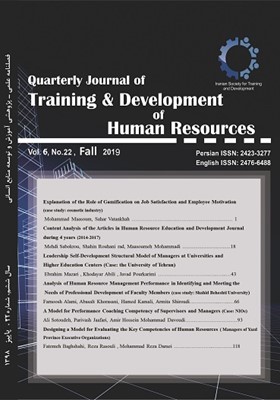A Model of Performance Coaching Competency for Supervisors and Managers(Case: NIOc))
Subject Areas :Ali Sotudeh 1 , Parivash Jaafari 2 , Amir hosein Mohammad davoudi 3
1 -
2 - دانشیار گروه مدیریت آموزشی ، واحد علوم و تحقیقات ، دانشگاه آزاد اسلامی ، تهران ، ایران.
3 -
Keywords: Model Coaching Performance Coaching Competency,
Abstract :
The aim of the present research is to put forward a model for Performance Coaching Competency regarding supervisors and managers in NIOC. This research is a heuristic inquiry with a pragmatic purpose wherein we have utilized the qualitative and quantitative data collection and analysis approaches .Data analysis strategy in qualitative inquiry comprises literature content analysis, interview and Delphi survey questionnaires analyses, Moreover, purposive sampling is applied in qualitative research inquiries. The sample size, in literature based upon data saturation and semi-structured interview, were 12 subjects and in Delphi method were 20 subjects of experts, people in charge, and managers familiar with performance coaching in NIOC. The questionnaires face validity was obtained via pilot implementation, the interview reliability via Double-coded Agreement Coefficient .The sample size, in ANP Method were 20 subjects of experts. Key concepts in the literature and semi-structured interviews were primarily extracted and then combined into 16 components on common grounds. Delphi questionnaires in two stages and then ANP questionnaire were made and implemented respectively. The literature data and the interview analyses were done inductively via MAXQDA software, Delphi Questionnaires via SPSS, ANP Questionnaire via MATLAB (for measuring the weight and importance of the dimensions and indicators) and Super Decision (for investigating the relation between dimensions and indicators and their mutual influence). Data analyses resulted in recommending a model for performance coaching which comprises 15 components and 56 indicators in three dimensions, namely: individual, organizational, and managerial; while expressing the ranking among indicators and their internal influence.
1- Barner, R. & Higgins, J. Understanding Implicit Models That Guide the Coaching Process. Journal of Management Development, (2007). 26, 148-158
2- Macrae, Rhoda. Coaching and Consolidating the Practice of Newly Qualified Social Workers: A Brief Literature Review. A Report Prepared for Social Work Resource, South Lanark shire Council, Management (2010)188-198
3- Lubans, J.. “The Spark Plug: A Leaders Catalyst for Change”, Library leadership and management(2009), 23 (2), 87-88
. 4- Anderson, D. & Anderson, M., Coaching that counts, Burlington, MA: Elsevier utter worth- Heinemann(2005)
5- Fairhurs, D. “We›re relying more & more on a learning and development tool with little evidence that it actually works”, Human Resources, (2010), pp 13-15
6- Douglas, G., Shaw, C., Schneier, E ., Richard, W. & Lloyd, S “Performance measurement ,management & appraisal sourcebook”, Human Resource Development Business & Economics, (1995), p. 528- 534
7- Sangari,Negin. Management in The Islamic University, )2017(Spring &Summer13,Vol. 6, No.1
8- Whitmore J.. Coaching for performance. London, UK: Nicholas Brealey Publishing )2014(
9- Payne, Kelly. Coaching Competencies Deconstructed. University of Pennsylvania Personal & Development, The Coaching Climate Survey Report(2017) .Available at: http://www.mai-bin.ro,
10- Lucia, A. D. & Lepsinger, R. The art and science of competency models. Pinpointing critical success factors in organizations. San Francisco: Jossey-Bass/Pfeiffer(1999)45-51
11- Dubois, D. D. (. Competency-based performance improvement: A strategy for organizational change. Amherst, MA: 1993) HRD Press.
12- Macclel & D.. Testing For Competence Rather Than For Intelligence. American Psychologist; (1973) Vol 20, PP.321-330
13- Parisi, Simon, Memoirs of a Semi-Detached Australian, Melbourne (2013)University Press, Carlton South, p. 17.
14- Kennedy, J.. A definition of Coaching. (2009)Available at http://www.kennedycoaching.com
15- Davidsoon, S.. How to choose the right coach. People Management. (2002) Vol 8, No 10, 16 May. Pp 54-55.
16- McKinney Christy, M. ; Mookherjee ,Somnath. Fihn ,Stephan D, Thomas H Gallagher, An Academic Research Coach: An Innovative Approach to Increasing Scholarly Productivity in Medicine (2019). 1Department of Pediatrics, Division of Craniofacial Medicine and Seattle Children’s Research Institute, University of Washington, Seattle, Washington
17- Orangzab, Ali; Muhammad Examining the Impact of Managerial Coaching on Employee Job Performance: Mediating Role of Work Engagement, (2018). Leader-Member-Exchange Quality, Job Satisfaction, and Turnover Intention
18- Campone, F. & Awal, DLife’s Thumbprint: The impact of life experiences on coaches and their coaching. Coaching: An International Journal of Theory, Research and Practice. (2012).. V 5 (1)
19- Payne, Kelly. Coaching Competencies Deconstructed. University of Pennsylvania Personal & Development, (2017)The Coaching Climate Survey Report .Available at: http://www.mai-bin.ro
20-- Sadr, Mohammad Mohammadi . Siyadat. Seyyed Ali, Hoveida. Reza . Identifying and Validating the Components of the Coaching Skill among. Faculty embers of Medical Sciences University of Isfahan. Journal of Education Strategies in Medical Sciences. No 47, Volume 11, Issue 01
21 -Hoseyni,Mahmmod.Rezazadeh,Ameneh.html.015_(2019)IICMO05-IICMO05-Paper/com.civilica.www://h
22- Daneshmand ,Hamid . Status The roles and performance coaching competencies of supervisors and their impact on the coaching results(2016). M.A. Thesis in Educational Management Ferdowsi University of Mashhad


